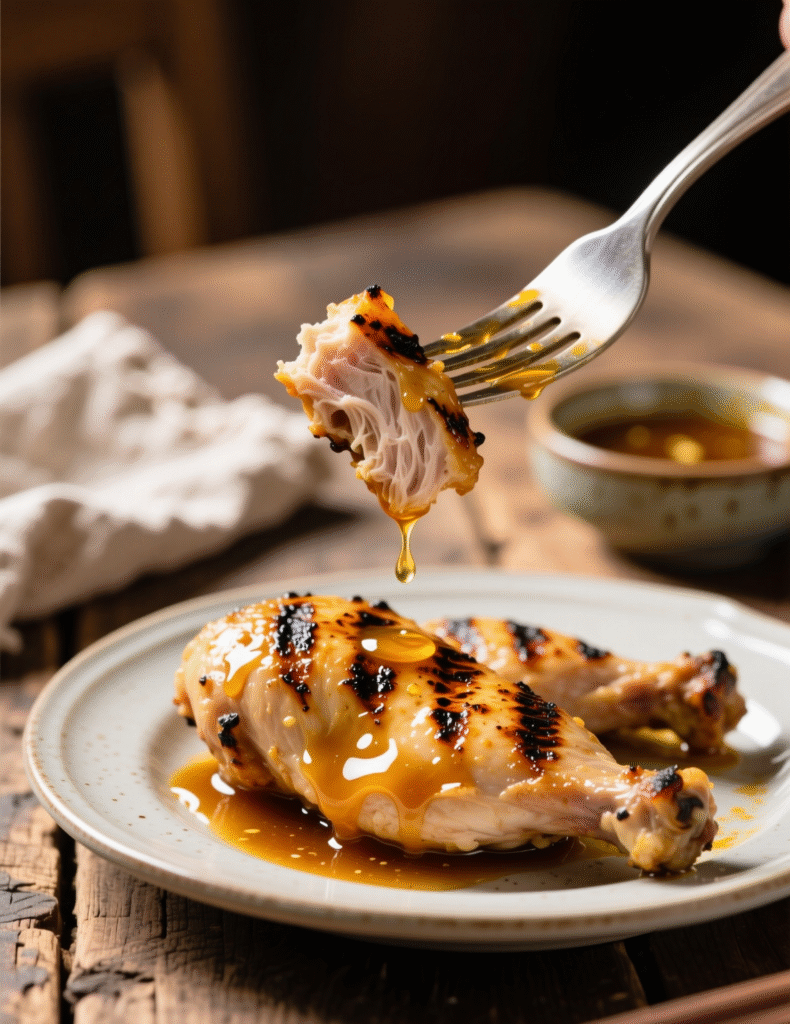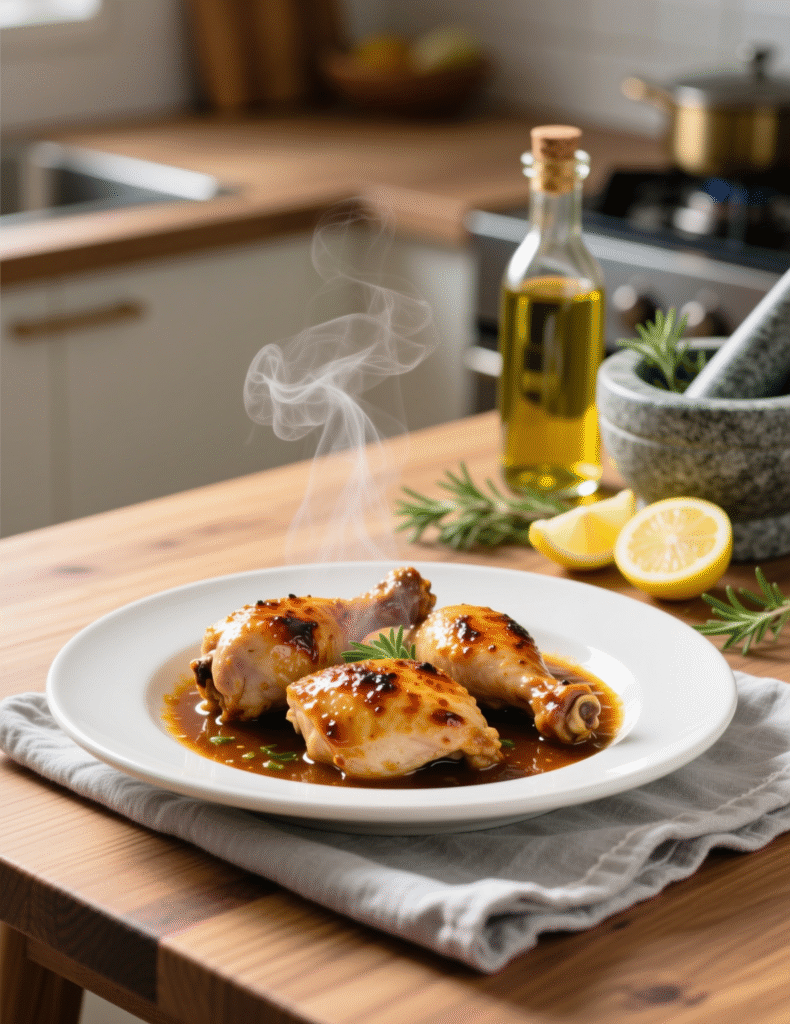If there’s one thing that separates a good chicken dish from a great one, it’s the marinade. That tender, juicy, flavor-packed bite doesn’t just happen by chance—it’s chemistry and craft at work. This 5-minute easy chicken marinade recipe isn’t your run-of-the-mill throw-it-together mix. It’s a culinary shortcut built on real technique, smart ingredient pairing, and a touch of that “chef’s intuition” we all chase in the kitchen. Whether you’re grilling, pan-searing, or roasting, this marinade will transform even the plainest chicken into something wildly flavorful.
Why Marinades Matter More Than You Think
Every chef knows a marinade isn’t just about taste—it’s about transformation. When you mix acid, fat, and aromatics in the right balance, you create an environment that softens muscle fibers and infuses flavor deep into the meat.
Acids like lemon juice, vinegar, or yogurt tenderize. Oils help lock in moisture and distribute fat-soluble flavors (like garlic or herbs). And then, the extras—spices, sweeteners, and umami boosters—add complexity.
Most home cooks over-marinate, thinking “more time equals more flavor.” It doesn’t. Chicken is delicate; too much acid, too long, and you’ll get a mushy texture. Five minutes, when done right, is enough to wake the meat up. That’s where this recipe shines—it’s fast, balanced, and deeply flavorful.
Ingredients for 4 Servings
- 1 ½ pounds (about 680g) boneless chicken breasts or thighs
- 3 tablespoons olive oil
- 2 tablespoons soy sauce
- 1 tablespoon lemon juice (fresh squeezed, always)
- 1 tablespoon honey or maple syrup
- 2 cloves garlic, minced
- 1 teaspoon Dijon mustard
- ½ teaspoon smoked paprika
- ½ teaspoon ground black pepper
- ½ teaspoon salt (adjust if your soy sauce is salty)
- Optional: pinch of crushed red pepper flakes for a light heat kick
That’s it. No 20-ingredient chaos, no hard-to-find spices. Just a simple, powerful combination of pantry staples that do all the heavy lifting.

The 5-Minute Magic — Step by Step
- Mix the Marinade
In a medium bowl, whisk together olive oil, soy sauce, lemon juice, honey, garlic, mustard, paprika, pepper, and salt. It should emulsify slightly, forming a glossy coating. You’ll notice the scent right away—sharp from the lemon, savory from the soy, and that faint sweetness from honey. That’s the sign you’ve hit the right balance. - Add the Chicken
Toss your chicken into the bowl and use tongs or your hands to coat every surface. Don’t be shy here—press the marinade into the meat a little. That mechanical pressure actually helps flavor penetration faster. - Let It Rest (Just 5 Minutes)
Five minutes is short, but it’s surprisingly effective. The salt and acid begin to denature the proteins, allowing flavor compounds to settle in. It’s like speed dating for flavor—brief but intense. - Cook Immediately
Grill, pan-sear, or bake the chicken right after marinating. Don’t rinse it, don’t pat it dry—the marinade helps caramelize beautifully during cooking.
Why This Marinade Works So Fast
Most marinades rely on time. But time isn’t the only factor—concentration and interaction are. This mix uses stronger flavor ratios and ingredients that act quickly. Soy sauce brings glutamates (natural umami compounds) that cling to proteins fast. Lemon juice’s citric acid immediately starts tenderizing. Honey acts as a carrier—it binds flavor molecules and spreads them evenly across the surface.
It’s chemistry meeting culinary instinct. In fact, a 2020 study in the Journal of Food Science found that marination efficiency depends more on pH and fat-soluble compounds than on duration alone. Translation? A potent 5-minute marinade can beat a weak overnight one.
Flavor Variations for Professionals
Even pros get bored of the same base. Here’s where creativity kicks in.
Asian-Inspired Twist: Replace lemon juice with rice vinegar, add grated ginger, and swap honey for brown sugar. A few drops of sesame oil give it that deep toasted note chefs love.
Mediterranean Style: Use white wine vinegar instead of soy sauce, add chopped oregano and a spoon of Greek yogurt. It makes the chicken incredibly tender, almost velvety.
Spicy Cajun Edge: Mix in cayenne, a splash of Worcestershire, and a touch of brown mustard. You’ll get smoky heat with a tang that hits just right on grilled thighs.
Each variation works within the same 5-minute frame. The key is keeping the acid-fat-salt balance steady while swapping flavors around.
Cooking It to Perfection
Once marinated, how you cook the chicken decides everything.
For grilling, preheat to medium-high. Grill breasts for 5–7 minutes per side until internal temperature hits 165°F (74°C). That slight char from honey and soy gives an irresistible golden crust.
For pan-searing, use a cast-iron skillet. Heat 1 tablespoon of oil until shimmering, then cook 5–6 minutes per side. Deglaze with a spoon of water or broth for a light glaze.
For baking, set oven to 400°F (200°C). Line a tray with parchment and bake for 18–20 minutes. Brush with leftover marinade halfway through for deeper color.
The trick: don’t overcook. A dry chicken will betray even the best marinade. Pull it off heat just before fully cooked—it’ll finish with carryover heat.
How to Use This Marinade for Meal Prep
This recipe is a goldmine for busy kitchens. You can prep and freeze chicken directly in the marinade. The freezing process slows down the chemical reactions, so the flavor deepens gradually. When you thaw, the meat is already seasoned and ready to cook.
For restaurants or meal delivery setups, this 5-minute marinade reduces prep stress while maintaining high flavor consistency. It’s scalable too—just multiply ratios, no adjustments needed.

Common Mistakes (and the Chef’s Fixes)
Mistake 1: Over-marinating
Acidic marinades turn meat grainy. Keep it under 30 minutes if you decide to wait longer.
Fix: For longer soaks, halve the lemon juice and add a spoon of yogurt to buffer acidity.
Mistake 2: Using metal bowls
Acids react with metal, creating off-flavors.
Fix: Always use glass or food-grade plastic containers.
Mistake 3: Forgetting salt balance
Soy sauce already brings salt. Many chefs add more out of habit and end up with briny chicken.
Fix: Taste the marinade before adding the meat. If it tastes balanced, so will your chicken.
Expert Tips for Deeper Flavor
- Use fresh garlic, not jarred—it changes everything. Pre-minced garlic often tastes metallic after heating.
- Always emulsify your marinade. Whisk until it thickens slightly; this ensures even coating.
- A pinch of baking soda (just a touch, 1/8 tsp) can make chicken even more tender—Chinese cooking secret.
- Don’t discard leftover marinade immediately. Boil it for a minute to kill bacteria, and use it as a glaze.
Nutrition & Health Insight
Here’s where the 5-minute marinade quietly wins hearts. Because it relies on natural ingredients, it’s low in saturated fats and sugars compared to bottled marinades.
Each serving (assuming 1/4 of the batch):
- Calories: ~220
- Protein: 32g
- Fat: 7g
- Carbs: 4g
- Sugar: 3g
- Sodium: 560mg
That balance supports a lean, protein-rich meal. Plus, using olive oil adds heart-healthy monounsaturated fats. For professionals catering to health-conscious clients, this is a major plus.
A Bit of Science Behind It All
Marination works on a molecular level. The salt from soy sauce loosens muscle fibers by dissolving myosin, the protein that tightens during cooking. That’s why marinated chicken feels softer and retains moisture better.
Acids, meanwhile, unravel surface proteins—just slightly—allowing other flavors to attach. Oils act as a delivery system, helping hydrophobic compounds like garlic oil penetrate. Think of it like painting a wall; oil ensures the pigment spreads evenly instead of clumping.
It’s fascinating, really, how a quick whisk and five minutes can set off such complex transformations.
Real-World Applications for Chefs
In restaurant kitchens, speed matters. A 5-minute marinade is a lifesaver during dinner rush. It allows last-minute prep without sacrificing flavor quality. It’s also excellent for catering setups—pre-marinated chicken can be portioned and cooked on-site with consistent results.
In food product development, this type of quick marinade appeals to consumers looking for “fresh flavor, minimal wait.” The blend of soy, lemon, and honey hits all the key sensory notes—sweet, salty, tangy, umami.
Even in fine dining, chefs often use flash marinades to layer complexity before sous vide or grilling. It’s not about shortcuts—it’s about efficiency with intention.
Emerging Trends in Marinade Development
Recent culinary trends lean toward clean-label marinades—meaning no artificial additives, emulsifiers, or stabilizers. Consumers want natural ingredients that still deliver restaurant-level flavor.
There’s also a rise in fermented bases—like miso or kombucha vinegar—used to replace synthetic acids. They provide depth and subtle umami notes that evolve with heat.
Finally, instant infusion technology in professional kitchens uses vacuum tumbling to accelerate marination even further. While not accessible to everyone, it shows where the industry is heading: maximum flavor in minimum time.
Frequently Asked Questions
Can I use this marinade on other meats?
Absolutely. It works on pork chops, shrimp, even tofu. Just adjust marination time—shrimp needs only 3 minutes.
Can I make it ahead?
Yes, mix and store in the fridge up to a week. The oil and honey help preserve the mix naturally.
Can I reuse marinade?
Not directly. But you can boil it for 2–3 minutes to make it safe and use as a finishing sauce.
What if I don’t have soy sauce?
Use tamari (for gluten-free) or coconut aminos. They bring similar umami notes.
How long should I marinate the chicken for?
Just 5 minutes is enough to infuse deep flavor without over-tenderizing the meat.
Can I use this marinade for other meats?
Yes, it works well with pork, shrimp, tofu, and even vegetables.
Can I prepare the marinade ahead of time?
Absolutely, you can make it up to a week in advance and store it in the fridge.
Is it safe to reuse leftover marinade?
Yes, but only after boiling it for a few minutes to kill any bacteria.
What’s the best way to cook marinated chicken?
Grilling, pan-searing, or baking all work beautifully depending on your preference.
Can I freeze chicken in this marinade?
Yes, freezing helps the flavors develop slowly for a richer taste when thawed.
Do I need to rinse off the marinade before cooking?
No, keep it on—the marinade caramelizes and adds flavor as it cooks.
What can I substitute for soy sauce?
You can use tamari or coconut aminos for a gluten-free or lower-sodium option.
Does the type of chicken cut matter?
No, but thighs tend to stay juicier, while breasts absorb flavors faster.
Is this marinade healthy?
Yes, it’s made with natural ingredients, low in sugar, and rich in healthy fats.
Conclusion
Five minutes. That’s all it takes to elevate your chicken from average to extraordinary. This easy chicken marinade blends precision with practicality, making it ideal for home cooks and professionals alike. It’s proof that flavor doesn’t have to wait overnight—it just needs the right chemistry and a confident hand.
So next time you’ve got chicken and five minutes, whisk, toss, and cook. You’ll taste the science, the art, and a bit of that culinary magic all at once.
Because sometimes, good cooking isn’t about time—it’s about understanding what time really does.

Marie Smith is a passionate recipe blogger, sharing easy, delicious, and creative culinary ideas that inspire home cooks to elevate everyday meals with flavor and simplicity.
